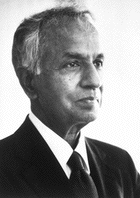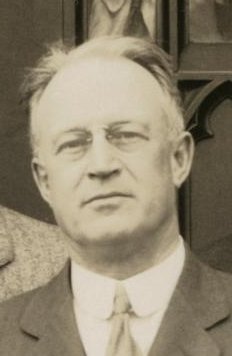Related Research Articles

Subrahmanyan Chandrasekhar was an Indian-American theoretical physicist who made significant contributions to understanding of stellar evolution, black holes, and the structure of stars. He was awarded the 1983 Nobel Prize in physics along with William A. Fowler for "...theoretical studies of the physical processes of importance to the structure and evolution of the stars". His mathematical treatment of stellar evolution yielded many of the current theoretical models of the later evolutionary stages of massive stars and black holes. Many concepts, institutions, and inventions, including the Chandrasekhar limit and the Chandra X-Ray Observatory, are named after him.
The Astrophysical Journal (ApJ) is a peer-reviewed scientific journal of astrophysics and astronomy, established in 1895 by American astronomers George Ellery Hale and James Edward Keeler. The journal discontinued its print edition and became an electronic-only journal in 2015.

Lyman Spitzer Jr. was an American theoretical physicist, astronomer and mountaineer. As a scientist, he carried out research into star formation and plasma physics and in 1946 conceived the idea of telescopes operating in outer space. Spitzer invented the stellarator plasma device and is the namesake of NASA's Spitzer Space Telescope. As a mountaineer, he made the first ascent of Mount Thor, with Donald C. Morton.

William Alfred Fowler (August 9, 1911 – March 14, 1995) was an American nuclear physicist, later astrophysicist, who, with Subrahmanyan Chandrasekhar, was awarded the 1983 Nobel Prize in Physics. He is known for his theoretical and experimental research into nuclear reactions within stars and the energy elements produced in the process and was one of the authors of the influential B2FH paper.

Viktor Amazaspovich Ambartsumian was a Soviet Armenian astrophysicist and science administrator. One of the 20th century's top astronomers, he is widely regarded as the founder of theoretical astrophysics in the Soviet Union.
Sir Ralph Howard Fowler was a British physicist and astronomer and physical chemist.
Donald Edward Osterbrock was an American astronomer, best known for his work on star formation and on the history of astronomy.

Leon Mestel was a British-Australian astronomer and astrophysicist and Emeritus Professor at the University of Sussex. His research interests were in the areas of star formation and structure, especially stellar magnetism and astrophysical magnetohydrodynamics. He was awarded both the Eddington Medal (1993) and the Gold Medal of the Royal Astronomical Society. Following his retirement, he wrote several obituaries and biographical articles on physicists and astrophysicists.

Basilis C. Xanthopoulos was a Greek theoretical physicist, well known in the field of general relativity for his contributions to the study of colliding plane waves.

Yousef Sobouti is a contemporary Iranian astrophysicist, theoretical physicist.

Spencer R. Weart is the former director of the Center for History of Physics of the American Institute of Physics (AIP) from 1971 until his retirement in 2009.

Henry Gordon Gale was an American astrophysicist and author.
Jacob Robert Emden was a Swiss astrophysicist and meteorologist. He is best known for his book, Gaskugeln: Anwendungen der mechanischen Wärmetheorie auf kosmologische und meteorologische probleme, published in 1907. It presents a mathematical model of the behaviour of polytropic gaseous stellar objects under the influence of their own gravity, known as the Lane-Emden equation.
Dannie Heineman Prize for Mathematical Physics is an award given each year since 1959 jointly by the American Physical Society and American Institute of Physics. It is established by the Heineman Foundation in honour of Dannie Heineman. As of 2010, the prize consists of US$10,000 and a certificate citing the contributions made by the recipient plus travel expenses to attend the meeting at which the prize is bestowed.

Robert M. Wald is an American theoretical physicist and professor at the University of Chicago. He studies general relativity, black holes, and quantum gravity and has written textbooks on these subjects.
Edmund Clifton Stoner FRS was a British theoretical physicist. He is principally known for his work on the origin and nature of itinerant ferromagnetism, including the collective electron theory of ferromagnetism and the Stoner criterion for ferromagnetism. Stoner made significant contributions to the electron configurations in the periodic table.
Henry Keith Moffatt, FRS FRSE is a British mathematician with research interests in the field of fluid dynamics, particularly magnetohydrodynamics and the theory of turbulence. He was Professor of Mathematical Physics at the University of Cambridge from 1980 to 2002.

Paul Frederick Zweifel was a mathematical physicist and a prominent leader in the mathematical theory of nuclear reactors and the mathematical development of linear transport theory, a discipline that encompasses neutron transport in the core of a nuclear reactor as well as the propagation of photons in radiative transfer.
Albert Edward Green was a British applied mathematician and research scientist in theoretical and applied mechanics.
Ganesan Srinivasan is an Indian physicist specializing in the fields of condensed matter physics, astrophysics and statistical physics. He is a visiting professor of the Indian Institute of Astrophysics and a former research scientist in the Raman Research Institute. He is also a current member of the High Energy Phenomena and Fundamental Physics and the Galaxies and Cosmology Divisions of the IAU.
References
- ↑ https://ww3.math.ucla.edu/in-memoriam-paul-h-roberts/
- ↑ Soward, A. M. (2023). Paul Harry Roberts. 13 September 1929—17 November 2022. BIOGRAPHICAL MEMOIRS OF FELLOWS OF THE ROYAL SOCIETY.
- ↑ "Paul Roberts - Fellow of The Royal Society (1979)" . Retrieved 3 January 2023.
- ↑ https://www.amacad.org/person/paul-h-roberts
- ↑ https://agupubs.onlinelibrary.wiley.com/doi/pdf/10.1029/00EO00042